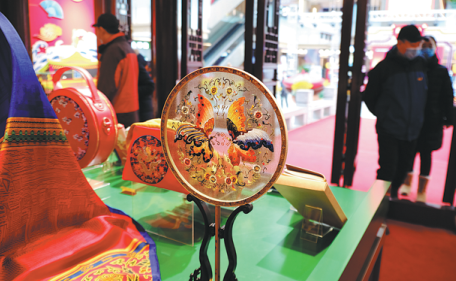Museums cash in on the past
Online and on-site sales for modern products that provide cultural links are on the rise, Xu Lin reports.
By Xu Lin | CHINA DAILY | Updated: 2021-02-17 12:56
 Tourists visit a store of creative products at Shenyang Palace Museum in Liaoning province on Nov 24. HUANG JINKUN/FOR CHINA DAILY
Tourists visit a store of creative products at Shenyang Palace Museum in Liaoning province on Nov 24. HUANG JINKUN/FOR CHINA DAILY
Efforts of innovation
Meanwhile, more domestic museums have won over consumers due to their continuous development of innovative products.
The late Chinese-American architect Ieoh Ming Pei designed the new Suzhou Museum in Jiangsu province which opened in 2006. It soon became a city landmark.
In 2020, the museum produced a series of products with quotes from Pei, printed bilingually, in commemoration of the first anniversary of his death. The design team, before developing the final creations, had read Pei's books and watched hours of interview videos in order to select 56 of his key observations about architecture and life.
The museum also owns a 480-year-old Chinese wisteria, planted by painter and calligrapher Wen Zhengming (1470-1559) of the Ming Dynasty (1368-1644).
Since 2013, the museum started to sell seeds from it for buyers to plant. Only 1,000 boxes are available every year, each of which has three seeds inside.
To design good products, according to Jiang Han, head of the museum's creative cultural products business, one needs to "have passion for the job, understand deeply the museum's exhibits and their history, and hold an insight into the industry".
Bookmarks, magnets and key rings used to dominate the museum's best-seller list.
In recent years, however, the museum's customers have cultivated a preference for a more varied selection of products due to the consumption upgrade in China-items like mugs and aromatherapy products, for example.
"It means a variety of products should be designed to meet the demands of customers, many of whom are youngsters," Jiang says. "Our designers were all born in the 1990s, and they can put themselves into the shoes of their peers."
In 2018, when the museum opened its official online store on Tmall, the number of annual visits quickly surpassed those to the museum itself.
Due to the COVID-19 pandemic in 2020, their annual sales figure dropped from 32 million yuan ($5 million) in 2019 to 25 million yuan last year.
In 2019, their online sales accounted for a third of the total, but in 2020, the ratio was about half.
"The pandemic has affected our physical stores, with a series of chain reactions. Our current development of new products is more focused on online platforms," she says.
As for the prices of these creative products, she says, those over 200 yuan are more popular in online stores than in traditional physical shops, while those at about 50 yuan are equally popular in both.
"It's probably because when someone wants to buy a decent gift online for others, they choose us," she adds.
Jiang attributes several things to their success. "It's good timing that the market needed such creative cultural products. Additionally, the museum has a good reputation and Suzhou city combines many distinctive features of the regions south of the Yangtze River," she says. "Our team is also adept at exploring these characteristics and presenting them as modern creative products."
























